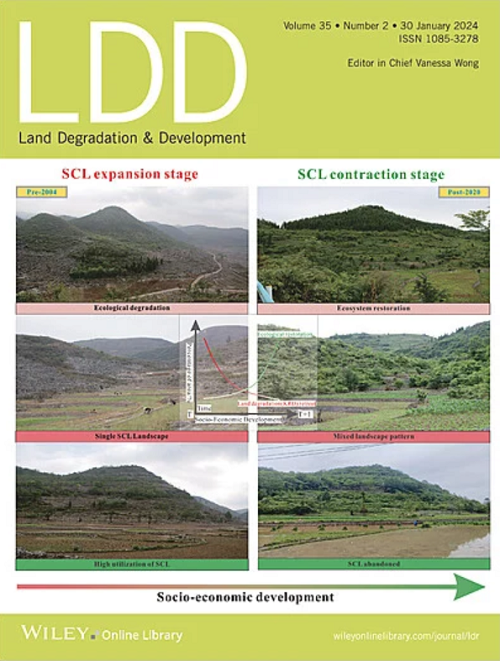Recalcification‐Driven Restoration of Degraded Calcareous Soil for Metal Sequestration: Insights From Soil Solution Chemistry Dynamics
IF 3.6
2区 农林科学
Q2 ENVIRONMENTAL SCIENCES
引用次数: 0
Abstract
Human‐induced carbonate depletion in the tillage layer of calcareous soils transforms critical metal sinks into significant pollution sources. This study compared the efficacy of agricultural/industrial byproducts (eggshell powder, shell powder, and sugar beet factory lime [SBFL]) versus natural lime materials (calcite and dolomite) for cadmium (Cd) and lead (Pb) immobilization during the recalcification of degraded calcareous soils. Analysis of soil solution chemistry revealed that SBFL uniquely combined pH elevation across all stages (0.12–1.16 units) with elevated dissolved organic carbon (DOC) concentrations at the seedling and jointing stages (145%–472% increase) to achieve dual Cd‐Pb stabilization. Principal component analysis identified distinct immobilization mechanisms: Cd immobilization was primarily pH‐driven via precipitation and co‐precipitation with calcium, whereas Pb stabilization relied on DOC‐mediated complexation under high pH conditions, effectively suppressing the reductive dissolution of iron and manganese oxides. Consequently, SBFL outperformed the other amendments, reducing root Cd/Pb concentrations by 11.8%–56.6% and enhancing wheat biomass by 25.9%–55.4% compared with the unamended control. These findings highlight the significant potential of industrial byproducts like SBFL to restore degraded calcareous soils through distinct geochemical pathways, reconciling crop productivity with metal sequestration.重钙化驱动的退化钙质土壤金属固存修复:来自土壤溶液化学动力学的见解
在钙质土壤的耕作层中,人为引起的碳酸盐枯竭将关键的金属汇转变为重要的污染源。本研究比较了农业/工业副产品(蛋壳粉、壳粉和甜菜厂石灰[SBFL])与天然石灰材料(方解石和白云石)在降解钙质土壤重钙化过程中固定镉(Cd)和铅(Pb)的效果。土壤溶液化学分析表明,SBFL独特地将所有阶段的pH升高(0.12-1.16单位)与苗期和拔节期溶解有机碳(DOC)浓度升高(145%-472%)结合起来,实现了双Cd - Pb稳定。主成分分析确定了不同的固定机制:Cd固定主要是通过沉淀和钙共沉淀pH驱动的,而Pb稳定依赖于高pH条件下DOC介导的络合作用,有效抑制铁和锰氧化物的还原性溶解。结果表明,与未处理的对照相比,SBFL处理的根系Cd/Pb浓度降低了11.8% ~ 56.6%,小麦生物量提高了25.9% ~ 55.4%。这些发现强调了工业副产品的巨大潜力,如SBFL通过不同的地球化学途径恢复退化的钙质土壤,协调作物生产力和金属封存。
本文章由计算机程序翻译,如有差异,请以英文原文为准。
求助全文
约1分钟内获得全文
求助全文
来源期刊

Land Degradation & Development
农林科学-环境科学
CiteScore
7.70
自引率
8.50%
发文量
379
审稿时长
5.5 months
期刊介绍:
Land Degradation & Development is an international journal which seeks to promote rational study of the recognition, monitoring, control and rehabilitation of degradation in terrestrial environments. The journal focuses on:
- what land degradation is;
- what causes land degradation;
- the impacts of land degradation
- the scale of land degradation;
- the history, current status or future trends of land degradation;
- avoidance, mitigation and control of land degradation;
- remedial actions to rehabilitate or restore degraded land;
- sustainable land management.
 求助内容:
求助内容: 应助结果提醒方式:
应助结果提醒方式:


